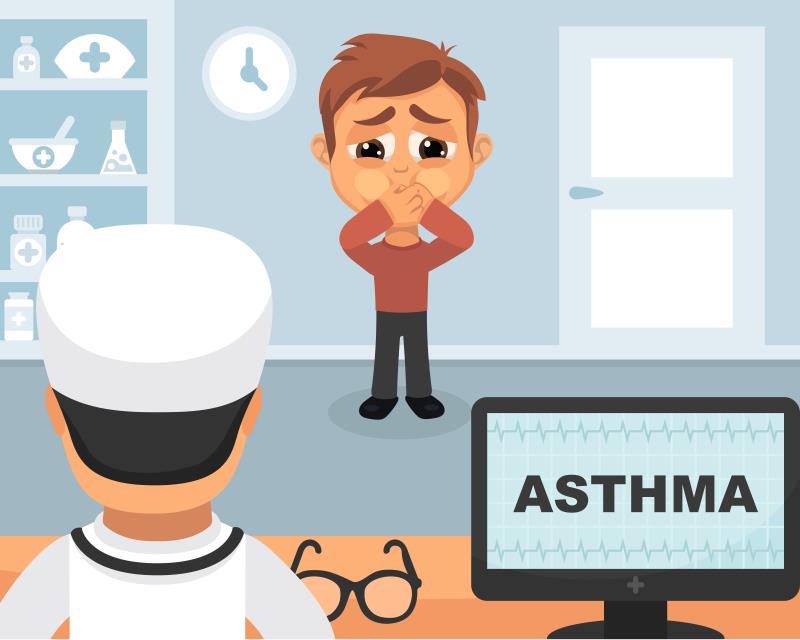No real-world evidence of montelukast link to neuropsychiatric adverse events in kids





The use of montelukast in children treated in routine practice does not appear to pose any risks of neuropsychiatric events such as anxiety, depression, and sleep-related disorders, among others.
In a large real-world study from Sweden, the incidence rate of the primary outcome of the composite of neuropsychiatric adverse events was 2.39 per 100 patient-years among the montelukast users as opposed to 2.41 per 100 patient-years among the long-acting β-agonists (LABA) users. The corresponding weighted hazard ratio (HR) was 0.99 (95 percent confidence interval [CI], 0.84–1.16). [JAMA Pediatr 2025;doi:10.1001/jamapediatrics.2024.5429]
Likewise, when the risk of neuropsychiatric adverse events was analysed individually, no substantial differences were seen between the montelukast and LABA users for anxiety (HR, 0.79, 95 percent CI, 0.54–1.14), depression (HR, 1.16, 95 percent CI, 0.70–1.95), sleep-related disorders (HR, 0.93, 95 percent CI, 0.76–1.13), suicide and suicidal actions (HR, 1.31, 95 percent CI, 0.64–2.69), disrupted control of activity/attention/behaviour (HR, 1.27, 95 percent CI, 0.84–1.90), and confusion and psychotic-like symptoms (HR, 0.51, 95 percent CI, 0.05–5.53).
Subgroup and sensitivity analyses yielded consistent results for the primary outcome.
“Suspected neuropsychiatric adverse effects of montelukast have been a major concern for patients, clinicians, and regulators since the signal emerged from spontaneous report in 2008 and FDA announced a boxed warning in 2020 advising against the use in patients with mild disease,” the investigators said.
Evidence from other studies is mixed, with an association between montelukast use and neuropsychiatric adverse events shown in cohort studies from Canada and Korea but not replicated in others. However, the investigators noted that the evidence from most methodologically sound studies have shown no association between drug and neuropsychiatric outcomes. [J Pediatr 2019;209:176-182.e4; Eur Respir J 2022;60:2102467; Pharmacoepidemiol Drug Saf 2015;24:435-445; J Allergy Clin Immunol Pract 2021;9:385-393.e12]
“In addition to other relevant paediatric studies, this [present] large-scale observational study can inform regulatory agencies and clinical practice,” they added.
The investigators highlighted the importance of robust safety data on montelukast given that the leukotriene receptor antagonist is widely used in the management of asthma and allergic rhinitis in children and adolescents. [http://www.ginasthma.org/]
“Oral montelukast offers systemic anti-inflammatory action and is primarily used as an add-on treatment in patients with mild-to-moderate chronic disease who do not achieve disease control with inhaled corticosteroids (ICS) and short-acting β-agonists. The uptake of montelukast is high and has increased rapidly in many countries during the last decades,” they added. [https://www.socialstyrelsen.se/statistik-och-data/statistik/statistikdatabasen/; https://www.fda.gov/drugs/drug-safety-and-availability/fda-requires-boxed-warning-about-serious-mental-health-side-effects-asthma-and-allergy-drug]
The current study included 74,291 children (mean age 12.3 years, 47.7 percent female), of which 26,462 used montelukast and 47,829 used LABA. Over a mean follow-up of 5.8 months, 310 neuropsychiatric adverse events in the montelukast users and 566 events in the LABA users were documented. Exposure was based on an incident dispensing of either montelukast or LABA.
The investigators acknowledged several study limitations. First, outcome events were primarily ascertained on the basis of diagnosis codes from specialized care, an approach that may be subject to misclassification bias, particularly due to low sensitivity, they said. Additionally, there is a potential for exposure misclassification, with the assumption that the dispensed drugs were used, and lack of consumption would bias a potential association toward the null.
“However, we assessed the association with current treatment and censored patients who did not refill their prescription within a short grace period of 60 days, which reduced the potential bias of low adherence,” the investigators said.